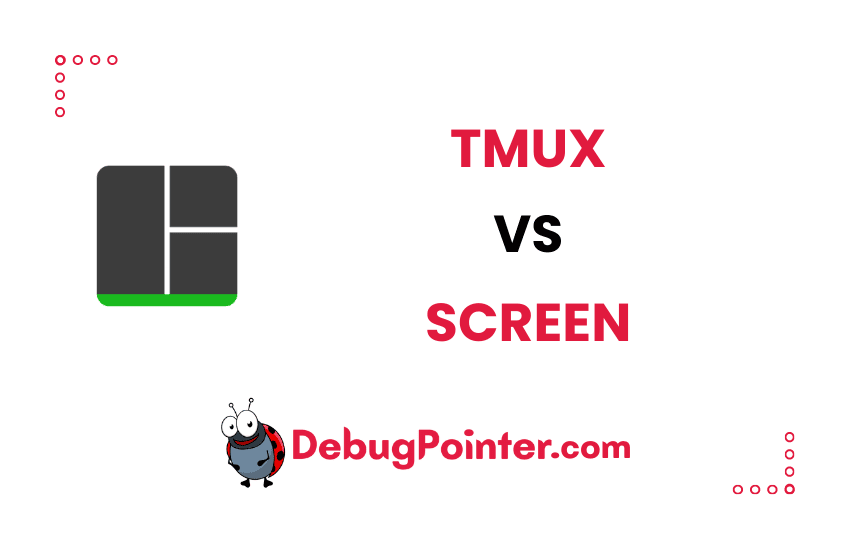In the dynamic world of programming, few things match the complexity and beauty of the command line interface. If you’ve been on this rollercoaster for a while, you’ve probably heard of Tmux and Screen. But which one is the real deal? That’s the question I’ll be helping you answer in today’s deep dive into Tmux vs Screen.
Newcomers, gear up with the basic knowledge of Tmux. Seasoned users, let’s not wait anymore and jump right in! Already a Tmux pro? Let’s cut to the chase! You can also check out the complete tmux cheatsheet of keyboard shortcuts and mouse shortcuts.
Introduction – Tmux vs Screen: A Detailed Look into Terminal Multiplexers
Before we hit the ground running, let’s first understand the essence of our competitors. Tmux (Terminal Multiplexer) and Screen are powerful utilities that allow you to manage multiple terminal sessions within one window. Although they have their individual quirks and features, their primary purpose remains the same: to simplify your command-line workflow.
Tmux vs Screen: An Overview
In the red corner, we have Tmux, a robust, modern terminal multiplexer with a wealth of features. And in the blue corner, we have Screen, the veteran of terminal multiplexing that’s stood the test of time. Let’s get ready to rumble!
Tmux: The New Kid on the Block
Despite being relatively newer than Screen, Tmux has taken the programming world by storm. It’s known for its flexibility, customization, and multiplexing prowess.
Screen: The Old Guard
Screen has been around for decades, offering a tried-and-true solution to terminal multiplexing. While it may lack some of the flashier aspects of Tmux, it has a stability and simplicity that many users appreciate.
Comparing Features: Tmux vs Screen
When comparing Tmux and Screen, it’s all about the features. So let’s put them side by side and see how they stack up.
Session Management
Tmux
Tmux allows for easy session creation, detachment, and reattachment. You can easily switch between sessions, windows, and panes with simple keyboard shortcuts. It also provides a visual indicator of your sessions, windows, and panes, making navigation a breeze.
Screen
Screen, too, provides session management, albeit in a more basic form. While it allows for session creation, detachment, and reattachment, it doesn’t provide the same level of visual feedback as Tmux. Switching between sessions and windows is also possible but can feel a bit more cumbersome than in Tmux.
Customization
Tmux
Tmux shines in the customization department. You can personalize just about anything in Tmux, from keybindings to status lines. You can also apply different configurations for individual sessions, giving you a high degree of flexibility.
Screen
Screen offers some customization options, such as keybindings and shell scripting integration. However, it doesn’t provide the same depth of customization as Tmux.
Scripting and Automation
Tmux
Tmux comes with an extensive command set that’s great for scripting and automation. This allows you to automate repetitive tasks and customize Tmux to your exact needs.
Screen
Screen also supports scripting, allowing you to automate common tasks. However, it lacks some of the advanced scripting capabilities of Tmux.
User Interface
Tmux
Tmux’s user interface is modern and clean. It provides visual feedback for your sessions, windows, and panes, making navigation easy.
Screen
Screen’s user interface is more barebones. It gets the job done, but lacks the visual flair of Tmux.
Tmux vs Screen: Pros and Cons
Every tool has its strengths and weaknesses. So, let’s weigh the pros and cons of Tmux and Screen.
Tmux
Pros
- High degree of customization
- Advanced scripting capabilities
- Modern, intuitive interface
Cons
- Can be overwhelming for beginners
- Slightly steeper learning curve
Screen
Pros
- Simple, straightforward interface
- Stability and reliability
Cons
- Limited customization
- Lack of advanced features
Conclusion
And there you have it, the Tmux vs Screen face-off. Both are robust, powerful terminal multiplexers capable of enhancing your command-line workflow. While Tmux may offer more bells and whistles, Screen holds its own with its straightforward simplicity and reliability.
In the end, the choice between Tmux and Screen boils down to personal preference and workflow needs. You might find the additional features and customization of Tmux more appealing, or you might appreciate the simplicity and straightforwardness of Screen. So, I say, give both a whirl, and see which one resonates with your command-line spirit.
Frequently Asked Questions
Before we wrap up this deep dive into Tmux vs Screen, let’s tackle some common questions.
1. Can I use Tmux and Screen on any operating system?
Both Tmux and Screen are compatible with UNIX-like systems. However, they might not work on Windows without additional software like Cygwin.
2. Which is easier to use, Tmux or Screen?
Ease of use can be subjective. Some might find the simplicity of Screen more appealing, while others might appreciate the advanced features of Tmux.
3. Can I use Tmux and Screen at the same time?
Yes, you can use Tmux and Screen concurrently. You could even use Tmux within a Screen session, or vice versa.
4. Which is better for scripting, Tmux or Screen?
While both support scripting, Tmux offers a more extensive command set, making it a better choice for advanced scripting.
5. Are Tmux and Screen open-source?
Yes, both Tmux and Screen are open-source.
6. Which should I choose, Tmux or Screen?
The choice between Tmux and Screen depends on your needs. If you want a modern, highly customizable multiplexer with advanced scripting capabilities, go for Tmux. If you prefer a simpler, time-tested solution, Screen is the way to go.
